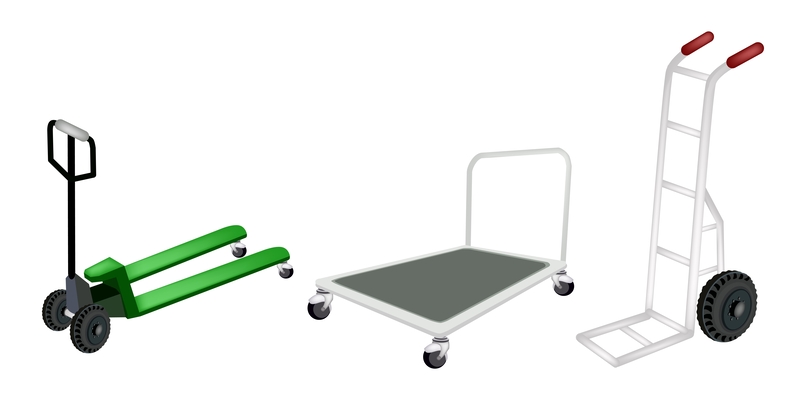What's Behind the Buzz About Kinetic Lifting?
Kinetic lifting has rapidly become the talk of the fitness and industrial sectors, drawing attention from professionals, enthusiasts, and curious learners alike. But what exactly is this innovative approach, and why is everyone discussing kinetic lifting right now? In this comprehensive guide, we'll delve into the science, benefits, real-world applications, and future prospects behind the buzz about kinetic lifting. Buckle up as we explore what makes this technique a revolution in modern movement and strength training!
Understanding Kinetic Lifting: More Than Just Moving Weights
At a glance, kinetic lifting might sound like traditional weightlifting with a fancy name. However, kinetic lifting incorporates cutting-edge principles of biomechanics, functional movement, and dynamic motion. Unlike static lifting, which focuses on raw strength, kinetic lifting leverages the body's natural energy systems to produce explosive, controlled, and efficient movements.
What Is Kinetic Lifting?
Kinetic lifting refers to a training and lifting methodology that emphasizes movement energy (kinetics) rather than simply lifting static loads. It involves a fluid and calculated use of force, integrating the body's kinetic chain, which is the sequence of joints and muscles working together during motion. This approach is not just about lifting heavier weights--it's about moving smarter and safer, optimizing performance while reducing injury risks.
- Performance-Oriented: Kinetic lifting uses controlled speed and acceleration, maximizing power output rather than just brute strength.
- Functional Training: Movements mirror those found in daily life or specific sports, enhancing practical strength and coordination.
- Biomechanically Efficient: The technique respects the body's mechanical advantage, leveraging optimal joint angles and muscle engagement.
- Energy Utilization: Tapping into the body's natural elastic energy for more powerful and efficient lifts.

Why Is Kinetic Lifting Trending?
The rising popularity of kinetic lifting techniques is driven by several compelling factors:
1. Enhanced Performance Across Disciplines
Sports professionals are always seeking methods to improve their performance. Dynamic lifting methods used in kinetic lifting foster better muscle recruitment and more skillful use of explosive power--critical for athletes in football, basketball, MMA, CrossFit, and more. Lifters experience:
- Faster gains in strength and endurance
- Superior agility and speed
- Greater transfer to sports and everyday activities
2. Scientific Backing and Advancements
The science behind kinetic lifting has been validated by sports scientists and kinesiologists. By leveraging concepts like the stretch-shortening cycle (SSC), kinetic lifting helps muscles store and release elastic energy, leading to far greater powerful movements. Technologies such as motion capture and force plates have fueled the optimization of kinetic lifting programs for individuals and teams alike.
3. Reduced Risk of Injury
Traditional lifting sometimes places excessive strain on joints and muscles, increasing the likelihood of injury. In contrast, kinetic lifting promotes alignment and coordination, minimizing awkward or unsafe angles. The focus on fluid, full-body movement spreads the load efficiently, reducing wear on individual parts and preventing overuse injuries.
4. A Shift Toward Functional Fitness
Modern fitness trends emphasize functional outcomes--being able to move, lift, jump, and bend with ease in real-world scenarios. Kinetic lifting's holistic and pragmatic approach fits perfectly with this trend, making it a favorite in CrossFit gyms, sports performance centers, and rehabilitation settings.
The Science and Mechanics: How Does Kinetic Lifting Work?
To understand what's behind the buzz, you need to appreciate the mechanics of kinetic lifting. Here's a breakdown of some essential scientific principles:
- Kinetic Chain Activation: Training the body to engage muscles sequentially--from feet to core to hands--achieves fluid, total-body lifts.
- Elastic Recoil: Exploiting the muscles' stretch-shortening cycle allows for a spring-like explosive movement, enabling heavier or more dynamic lifts with less perceived effort.
- Angular Velocity: Harnessing the speed at which joints move, efficiently transferring force through the body, contributes to optimal output.
- Motor Learning: Practicing kinetic lifts sharpens neuromuscular connections, so responses during lifts become faster, smoother, and more reflexive over time.
Examples of Kinetic Lifting Movements
While the concept is rooted in complex science, kinetic lifting can be applied to common exercises, such as:
- Kettlebell Swings: Using hip drive and elastic energy to propel the weight
- Clean and Jerk: Coordinating legs, hips, and arms in a chain reaction of explosive motion
- Jump Squats: Employing both force production and controlled landing (eccentric and concentric muscle actions)
- Medicine Ball Slams: Utilizing momentum and body rotation to transfer force from the ground, up through the torso, and into the arms
Benefits of Kinetic Lifting: Why You Should Care
The advantages of kinetic lifting are well-documented and appeal to a broad range of individuals, from elite athletes to seniors seeking safer movement training. Here are the top benefits fueling the conversation:
1. Increased Power and Performance
Kinetic lifting allows you to tap into more explosive strength by using the body's natural mechanics. This translates to higher vertical jumps, faster sprints, quicker reflexes, and greater agility--key to athletic success.
2. Improved Muscle Coordination and Balance
Unlike isolated lifts, kinetic movement practice involves multiple muscle groups firing in concert. Over time, lifters develop better core stability, proprioception (body awareness), and dynamic balance.
3. Better Transfer to Everyday Life and Sports
Functional strength gained from kinetic lifting helps people lift groceries, climb stairs, or carry children with ease and confidence--mirroring the demands of daily life and most sports.
4. Enhanced Calorie Burn and Cardiovascular Fitness
Because kinetic lifts involve full-body, high-intensity movement, they burn more calories than static lifts and boost the heart rate. It's an effective way to combine strength and conditioning in a single workout.
5. Reduced Injury and Joint Strain
By respecting the body's natural movement patterns, kinetic lifting distributes load evenly across joints and muscles, lowering injury risk and supporting long-term health.
Kinetic Lifting for Different Audiences
One of the reasons for the widespread buzz about kinetic lifting is its versatility--everyone can benefit!
Athletes and Sports Professionals
Teams in football, basketball, and track are adopting kinetic lifting to build explosive power, improve fast-twitch muscle fiber recruitment, and minimize time lost to injury. Personalized kinetic lifting programs are now a staple at elite sports performance facilities.
Fitness Enthusiasts and Personal Trainers
Kinetic lifting is being embraced in gyms, home settings, and group classes. Personal trainers are integrating it into routines to accelerate client progress, keep sessions exciting, and promote lifelong movement health.
Industrial Workers and Occupational Safety
In warehouses and logistics, kinetic lifting principles are revolutionizing employee training. Teaching staff to move loads with proper mechanics is reducing repetitive strain injuries, boosting productivity, and lowering insurance costs.
Physical Rehabilitation and Older Adults
Physical therapists are applying kinetic lifting in rehabilitation, using gentle, functional lifts to restore coordination and mobility. For older adults, supervised kinetic training builds confidence, helping maintain independence for years to come.
How to Get Started with Kinetic Lifting
Interested in joining the kinetic lifting revolution? Here are practical tips to begin:
- Work with a trained professional: Seek trainers or therapists educated in biomechanics and kinetic methods.
- Start with bodyweight exercises: Master movement patterns--like squats, hinges, and pushes--before adding external weight.
- Focus on form and fluidity: Quality over quantity. Use slow-motion movement to find optimal technique.
- Integrate dynamic tools: Try kettlebells, medicine balls, or resistance bands for varied kinetic loading.
- Progress gradually: Allow the neuromuscular system to adapt as you increase complexity or load.
Common Myths and Misconceptions About Kinetic Lifting
Despite its popularity, kinetic lifting is sometimes misunderstood. Let's debunk the most common myths:
- It's only for athletes: Kinetic lifting methods can be scaled for any age and skill level.
- It replaces traditional lifting: Kinetic exercises often complement classic lifts for a well-rounded program.
- It's dangerous or risky: When taught properly, kinetic lifting is safer for joints and ligaments than heavy static loads.
- It doesn't build real strength: Kinetic methods produce functional and athletic strength, not just muscle bulk.
Expert Insights: What the Pros Say About Kinetic Lifting
Leading coaches and physiologists endorse dynamic lifting techniques for their rewards. Dr. Jane Meyers, a sports scientist, notes, "Kinetic lifting empowers athletes to use their whole bodies efficiently. It's a paradigm shift in how we approach both training and movement health." Meanwhile, top trainer Alex Gordon adds, "Incorporating kinetic chain exercises makes a huge difference in client agility, stability, and injury prevention."

Future Trends: Where Is Kinetic Lifting Headed?
The buzz around kinetic lifting shows no signs of slowing. Upcoming trends include:
- Wearable motion-sensing technology to analyze kinetic chain efficiency and optimize form
- AI-powered fitness apps that offer real-time feedback during kinetic lifts
- Growth in workplace wellness programs using kinetic principles for safety and efficiency
- More research on long-term benefits and rehabilitation outcomes
The integration of smart tech and deeper biomechanical research will further cement kinetic lifting's place at the center of health and performance.
Conclusion: Why the Hype Is Justified
So, what's behind the buzz about kinetic lifting? It's the powerful combination of advanced science, practical benefits, broad applicability, and proven safety that is reshaping how we approach strength training and movement. Whether you're an athlete, coach, worker, or fitness newbie, integrating dynamic lifting techniques and respecting your body's kinetics can unlock a whole new level of performance and well-being.
If you're looking for the next frontier in fitness, injury prevention, or functional strength, now is the perfect time to explore and experience kinetic lifting. Start moving smarter--your body will thank you!



